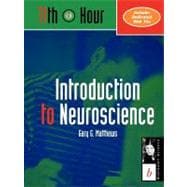
Note: Supplemental materials are not guaranteed with Rental or Used book purchases.
Purchase Benefits
What is included with this book?
Gary G. Matthews is the editor of 11th Hour: Introduction to Neuroscience, published by Wiley.
| 11th Hour Guide to Success | viii | ||||
| Preface | ix | ||||
| Unit I: Organization of the Nervous System | 1 | (22) | |||
|
3 | (9) | |||
|
3 | (2) | |||
|
5 | (7) | |||
|
12 | (11) | |||
|
12 | (2) | |||
|
14 | (3) | |||
|
17 | (6) | |||
| Unit II: Electrical Properties of Nerve Cells | 23 | (32) | |||
|
25 | (10) | |||
|
25 | (3) | |||
|
28 | (7) | |||
|
35 | (9) | |||
|
35 | (3) | |||
|
38 | (6) | |||
|
44 | (11) | |||
|
44 | (3) | |||
|
47 | (8) | |||
| Unit III: Sensory Systems | 55 | (64) | |||
|
57 | (9) | |||
|
57 | (3) | |||
|
60 | (6) | |||
|
66 | (15) | |||
|
66 | (3) | |||
|
69 | (4) | |||
|
73 | (8) | |||
|
81 | (14) | |||
|
81 | (4) | |||
|
85 | (2) | |||
|
87 | (8) | |||
|
95 | (10) | |||
|
95 | (4) | |||
|
99 | (6) | |||
|
105 | (14) | |||
|
105 | (3) | |||
|
108 | (11) | |||
|
115 | (4) | |||
| Unit IV: Motor Control Systems | 119 | (54) | |||
|
121 | (11) | |||
|
121 | (4) | |||
|
125 | (7) | |||
|
132 | (12) | |||
|
132 | (3) | |||
|
135 | (9) | |||
|
144 | (10) | |||
|
144 | (4) | |||
|
148 | (6) | |||
|
154 | (9) | |||
|
154 | (2) | |||
|
156 | (7) | |||
|
163 | (10) | |||
|
163 | (4) | |||
|
167 | (6) | |||
| Unit V: Higher Neural Functions | 173 | (30) | |||
|
175 | (9) | |||
|
175 | (3) | |||
|
178 | (6) | |||
|
184 | (9) | |||
|
184 | (3) | |||
|
187 | (6) | |||
|
193 | (10) | |||
|
193 | (3) | |||
|
196 | (7) | |||
| Unit VI: Molecular Neuroscience | 203 | ||||
|
205 | ||||
|
205 | ||||
|
208 | ||||
|
215 | ||||
|
215 | ||||
|
218 | ||||
|
223 | ||||
|
227 |
The New copy of this book will include any supplemental materials advertised. Please check the title of the book to determine if it should include any access cards, study guides, lab manuals, CDs, etc.
The Used, Rental and eBook copies of this book are not guaranteed to include any supplemental materials. Typically, only the book itself is included. This is true even if the title states it includes any access cards, study guides, lab manuals, CDs, etc.